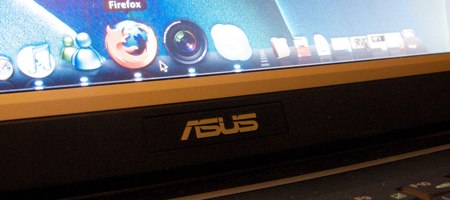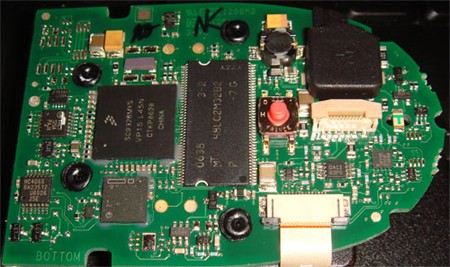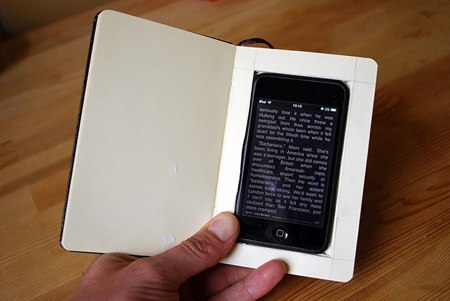
Nokia LCDs have been a popular choice for hardware projects for quite a while. [Ramandeep] published a how-to on interfacing the 1100 series LCD with a PIC controller. The 1100 features easily soldered contacts and a backlight, making it an good choice for adding an LCD to your project.
Month: June 2008
Making Music With The Eee PC

Create Digital Music has been watching the Asus Eee PC closely. The laptop’s portable nature and low price-cheaper than a turntable-have made them desirable to both producers and performers. CDM has collected links to many people that are figuring out how to leverage the lightweight rig. [Dan Stowell] put together a tutorial for SuperCollider, the real time audio synthesis engine. The machine is good for simple text based tracker software too. On the Windows side, a lot of software, like Guitar Rig, can be enabled with just a little display driver hacking. This really makes us wonder when we’ll see the first Eee PC keytar mod.
EFiX Boots Leopard Retail DVDs On Generic Hardware

On June 23rd, EFiX is planning on releasing a USB dongle that will let any PC boot and install OSX from a retail DVD. The commercial device is supposed to take care of all patching and other woes OSX86 enthusiasts have had to deal with. Very little information is provided other than a statement that the development process took a lot of time and that they overcame “sabotage”… so, it’s got that going for it. Major OSX86 contributor (and Psystar hater) [Netkas] received a device to test and was pleased with the results. We’re just going to wait and see what happens. Not that it matters; they have no plans of releasing it in the US.
[via InsanelyMac]
[photo: Mario Seekr]
Singing Tesla Coils
The video above is ArcAttack! playing the classic “Popcorn” through their signature Tesla coils. Solid state Tesla coils (SSTC) can generate sound using what [Ed Ward] calls pulse repetition frequency (PRF) modulation. The heat generated by the plasma flame causes rapid expansion of the surrounding air and a resulting soundwave. An SSTC can be operated at just about any frequency, so you just need to build a controller to handle it. The task is made more difficult because very few electronics are stable in such an intense EM field. [Ed] constructed a small Faraday cage for his microcontroller and used optical interconnects to deliver the signals to the Tesla coils.
[via Laughing Squid]
Name That Ware

Guessing games are fun, especially when unnamed hardware and prizes are involved. [bunnie] holds a Name that Ware contest on his blog once a month; he posts an image of hardware components like the PCB above (which is May’s mystery ware) and asks visitors to try to guess the machine it came from or at least its function. Aside from the prizes he gives out, winners get the most coveted of all rewards: bragging rights. He’s been running the monthly contest for quite some time and it’s not always PCBs; past wares have included this micron thickness guage (internal) and an xray of a crystal oscillator.
Drawing Images On A Character Display

[Dean Hall] doesn’t seem to know his Simpsons characters very well, but that didn’t stop him from coming up with this method for displaying a bitmap on an LCD character display with a Hitachi HD44780 chip.
[Hall] used an LCD with two 16 character rows and 8×5 pixels in each character. He displayed the image over 2×3 characters, which gave him 17×18 pixels (including the spaces between the characters) to work with. The first step after acquiring an image is to rasterize the image by hand onto graph paper. This won’t be scanned, it’s just a diagram to determine which pixels to light up.
Once the 6 characters were determined, [Hall] used this handy web-based tool to convert his graphed diagram to bitmap data. The data is loaded onto the microcontroller and the image shows up on the LCD. This is a pretty straightforward project, just be sure you properly identify your monkeys.
[via YourITronics]
Covert IPhone Moleskine Case

Crafting isn’t really our thing, but just last week we were planning on doing this project. Thanks to the how-to singularity: the longer we wait, the more likely someone else will do our dirty work. The instructions are this:
- Cut a hole in a book.
- Stick your phone in that book.
- Let her open the book.
Wired’s write up has about 600 more words if you need clarification. The ebook on the screen is Cory Doctorow’s Little Brother, so expect to see this on BoingBoing… and again when it’s fan translated into Polish. [bre] made a similar hidden compartment book last Fall for Make’s PDFcast.
In all seriousness, we do enjoy the idea of carrying an innocuous little book around that could be doing some covert WiFi scanning, acting as a mobile accesspoint, or live streaming our location to friends. Unfortunately, since it’s an iPhone, most of this isn’t possible yet; you can’t even voice dial from your headset, while leaving the notebook in your pocket. This case also blurs what is considered rude. Most people would be annoyed if you started txting mid conversation, but people taking notes in Moleskines don’t get the same treatment.










